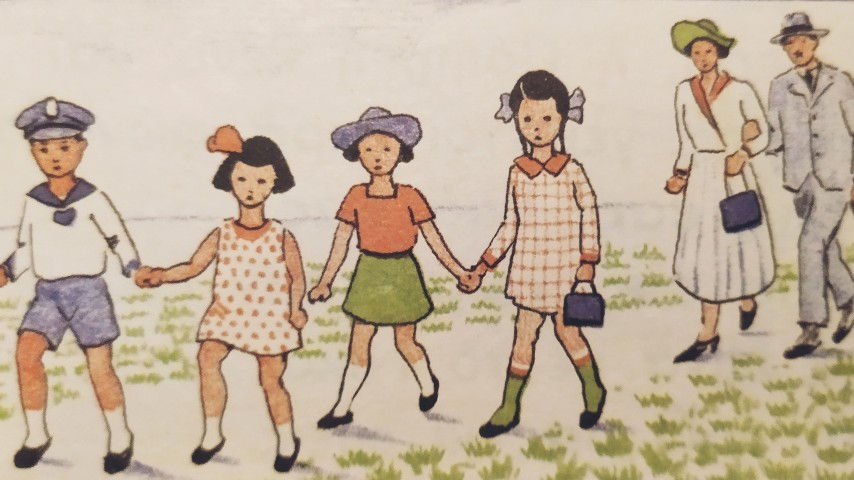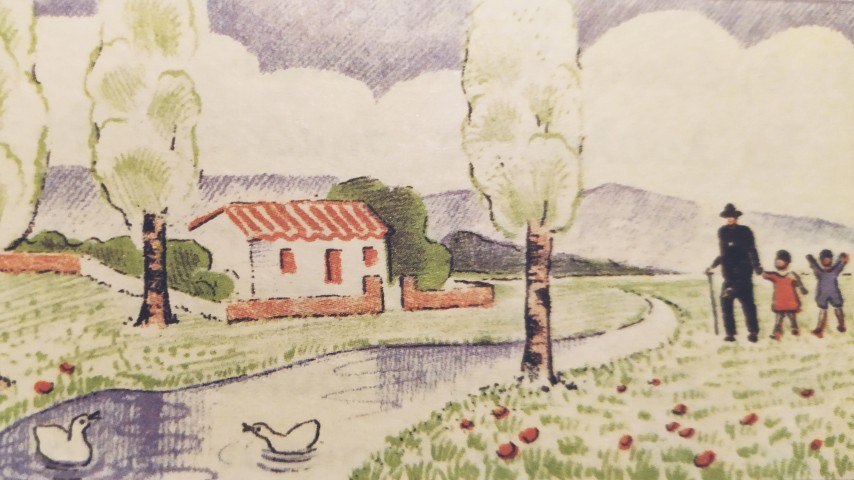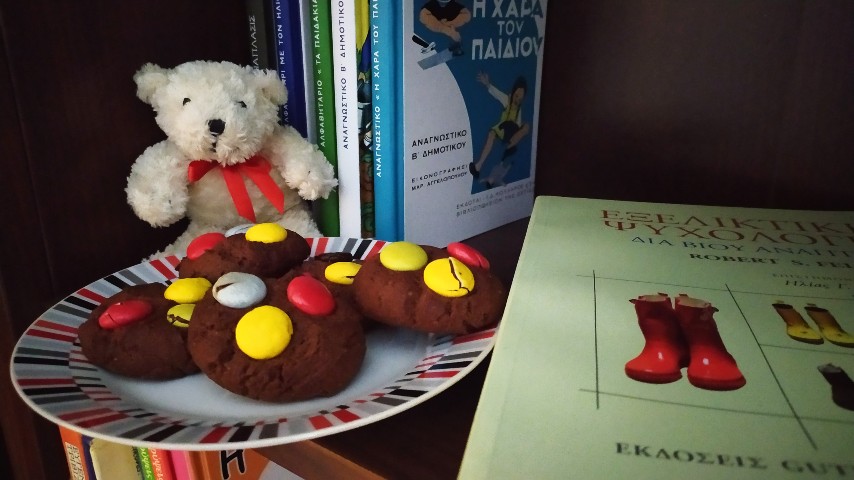A few days ago we posted on our Instagram profile a favourite recipe of ours, not to devour it -as we usually do- but to share it and put it in our minds and our souls. The sweet of serenity is made with a simple heart, a peaceful conscience, a happy face, love, laughter and nature. And it is by all means delicious!

You can download the free picture we created with the translated recipe for The sweets of serenity, print it and hang it in your house like we did!
Everyday in the news, but also in our surroundings, we see and meet children that grow up in -less or more- difficult family conditions. We decided to investigate and write down some of our thoughts, without aiming at giving advice or directions (we couldn’t do that anyway) but driven by our hope that our thoughts may touch some hearts and offer even a little joy and tranquility.
It is a fact today (at least in theory) that children must grow up in a safe, stable and nurturing environment. The meaning of these words may seem obvious, but it doesn’t hurt to mention their definition, as we found it in an informative brochure: Safety concerns the extent to which children have no fears and face no dangers as for their psychological and physical well-being. Stability relates to the predictability and consistency that characterises the children’s physical, psychological and social environment. Nurturing means a consistent and sensitive response to children’s physical, sentimental and developmental needs.

To be more particular, we read in an article by Dr. Gail Cross that a stable home is important for children’s development, so that they gain confidence and therefore less anxiety in their lives. That way, they will perform better in everything they do and will believe in themselves, no matter what. Resilience is a term used in scientific discourse to describe the ability to cope with stressful situations and to recover quickly from difficulties. But beware not to confuse resilience with hardness, individualism or indifference. Developing resilience goes hand in hand with supporting relationships with parents, as well as other responsible adults, relatives or teachers. Strength of character can be built only through quality relationships and meaningful interactions with others.

For a child to develop a sense of security and confidence, a major role -but not exclusive- plays infancy. The bond that a baby forms with its caregivers will define its future sentimental, social and cognitive development. These matters are studied by Developmental Psychology. In a relevant book, Development Across the Life Span, Feldman describes John Bowlby’s (a British psychoanalyst) attachment theory. According to his theory, infants develop attachment behaviors to their caregivers, that define the extent of their security feeling. It is a kind of safe family base, that ensures children’s gradual independence. In a person’s life course, the people to whom he gets attached change. This indicates that bonding with others is a lifelong continuing procedure.

Everything points to the fact that a calm and supportive environment is absolutely necessary for a child to gain enough confidence in order to face and solve its problems in its future life. According to Dr. Rachel Wood, children see the world through their relationships with their parents (or other caregivers). However, a good and stable relationship between parents and children is not enough. Parent’s relationships with other adults are also important. As Konstantina Arkoumani states, if a family is unable to form loving and strong bonds with its relatives, that may lead to children’s antisocial behaviour and disfunctional future relationships.

Dr. Gail Cross notices that neuroscience research has proven that children who experience high stress levels (because of poverty, family violence, divorce, fighting at home etc) showcase high levels of cortisol, the so-called stress hormone. The effects on children’s brain architecture and impulse control are really bad, and they may also manifest as physical disease. Dr. Rachel Wood adds that except for the negative effects of “toxic stress” on children’s physical and mental development, it can also affect their memory and learning ability.
Harvard’s Center on the Developing Child has conducted a great amount of research on such matters. In an article we read this exceptional motto…
Toxic stress can feel like a heavy weight, but communities can share the load.
Center on the Developing Child, Harvard
Harvard’s researchers firmly believe that understanding how stress affects us is the first step towards changing our lives, and consequently our community. They promote an optimistic message, stating that toxic stress is not the end to anyone’s story. For the kids there is a simple solution: love, nurturing, attention and clear boundaries, hugs, play, talks and walks… Small things that given their many advantages to children -and to adults also we’d like to add- become automatically huge!

From all that, let’s keep in mind that no matter what is going on and regardless of how hard everything may seem, it isn’t the end. We very well know that everyday life is tough, problems are many and stress and nerves are unavoidable. What we can do though, is transform our home into a refuge and find ways to bring some calmness that will soothe ourselves, as well as our loved ones. Let’s back down in fights, let’s let our ego and stubbornness go, let’s discuss with good will and sincerity, let’s avoid fighting and sharing cruel words. Let’s have courage, let’s acknowledge our mistakes, let’s ask for forgiveness, let’s get up and move on. Let’s make pure and creative thoughts and let’s put our time in nice occupations, let’s create an “industry of good thoughts” as Saint Paisios of Mount Athos used to say. Let’s put priority in love, calmness, understanding, and let’s prize life’s little things… Let’s believe that those have indeed the power to bring serenity. And let’s become kids for a while!

… each and every day, we all deserve at least one cookie.
Christina Tossi, Milk Bar Life

To lighten the mood a little, Rupert insists on sharing with you a recipe… just because sweets make us smile! A super-easy, great for kids and delicious recipe for candy cookies… because a Christina Tossi writes in her book Milk Bar Life (get it here), everyone deserves at least one cookie a day!

Homemade candy cookies
Our recipe
Ingredients for the cookies
| Cake flour (sifted) | 240 g |
| Cocoa powder | 40 g |
| Butter (room temp.) | 125 g |
| Egg | 1 |
| Granulated sugar | 80 g |
| Brown sugar | 80 g |
| Honey | 1 tbs |
| Baking soda | 1/2 tsp |
| Salt | 1/2 tsp |
| Vanilla extract | 5-6 drops |
| Candy (filled with peanutbutter, order online) | 150 g |
Method for the cookies

In a bowl, mix the flour, the cocoa powder, the baking soda and the salt. In another one, beat the softened butter with the two types of sugar, with a mixer on medium speed for 5 minutes (or by hand with a wooden spoon). In a small bowl mix the egg with the vanilla and the honey. Pour the egg mixture gradually into the butter and mix to incorporate. Add the dry ingredients and mix with a wooden spoon or a spatula.

Cover two trays with baking paper. Use a measuring spoon (ours is a measuring spoon for filter coffee) or an ice cream scooper to prepare scoops with the cookie dough. Arrange on the trays, without forgetting to leave some distance between them as they will spread in the oven. Add candy on top to make them look yummy. If you don’t want your cookies to spread, put the trays in the refrigerator for 15 minutes -we baked ours right away.

Bake in a preheated oven at 175 °C for 12-15 minutes (depending on your oven). As soon as they come out of the oven the cookies will be soft, but no worries, after cooling their texture will be perfect: crunchy on the outside and soft in the centre. Ready! Keep them in a well-sealed cookie jar or box and they will be as tasty for many days… If there is any left!

Be the first one to read our new articles!
Follow us by submitting your email into the box you will find if you scroll down our page, so that you receive each new article by email as soon as it is online. Don’t forget to confirm your subscription, in the email you will receive! 🤗 For wordpress bloggers like ourselves, just press the follow button. Follow us on Instagram (@eatdessertfirstgreece) and follow our new Facebook page (eatdessertfirstgreece) to see our posts with our favourite desserts… and much more!


One Comment Add yours